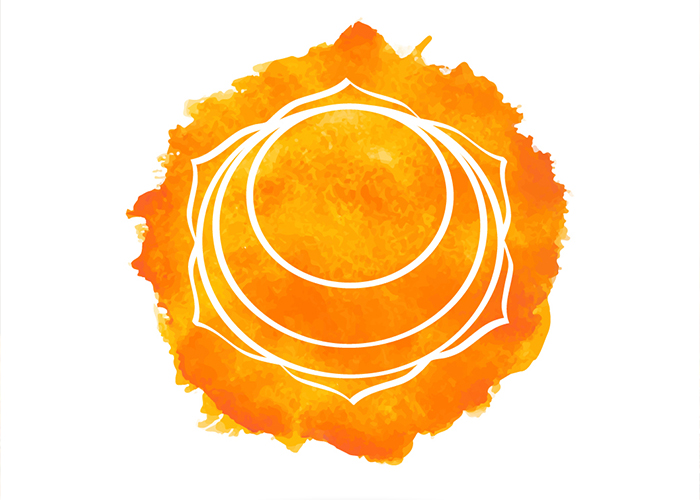This post is part of the Chakras Series. We started by covering what the chakras are and what they represent (Read “What Are The 7 Chakras And Why Do They Matter?”).
In this post, we will focus specifically on the Sacral Chakra.
- Also known as: Svadhisthana Chakra. The word Svadhisthana is a combination of two Sanskrit words: “Sva,” which means “Aelf” and “Athana,” which means “Place”.
- Location: Lower abdomen, about two inches below the navel and two inches in.
- Color: Orange
- What it represents: I FEEL. Known as the second chakra, it’s responsible for our sexual and creative energies.
- Linked to: Our ability to feel creative, sexual, with sense of abundance and flexibility to accept change.
- You have a balanced sacral chakra when: You’re friendly, passionate, and successfully fulfilled. You experience feelings of wellness, abundance, pleasure, and joy. By honoring your body and expressing yourself creatively, you’re keeping the energy wheels turning and fluid.
- You have a blocked sacral chakra when: You’re feeling uninspired creatively or have some emotional instability. You might experience fear of change, depression, or addiction-like behaviors. Physical ailments can include back pain, sexual dysfunction, and urinary and kidney infections.
- Healing foods: Orange foods such as carrots, mango, oranges, orange peppers, peaches, apricots, papayas, pumpkin and sweet potatoes. Foods rich in Omega-3s, such as salmon, also work well to balance this chakra. Nuts and seeds such as flax, almonds, walnuts, and sesame provide additional fatty Omega-3s, which aid in cardiovascular health and reduce inflammation.
- Healing yoga poses: Hip openers and poses that create space and energy flow in your lower spine. When you are in a pose, try to breathe deeply and set an intention that helps you relax and connect to your intuition. Ideas can be “I soften”, “I open up space”, “I am fluid”.
“Here are my favorite yoga poses to stimulate the Sacral Chakra”

- Balasana: Separate your knees wide and rest your forehead on the floor. Let your whole body relax, while maintaining a straight spine. Allow the breath to help you soften your pelvis area and gently open up your hips.
- Cat-cow and hip circles: Push up to tabletop, with your knees under your hips, and your wrists under your shoulders. As you inhale, arch your body back and look up, allowing your tailbone to flare. As you exhale, round your spine down like an angry cat, draw your navel in and tuck your tailbone down. This will help you warm up the spine and invite a sense of fluidity. After at least 10 breaths, come back to a neutral spine. Keep breathing slowly and deeply. Make small circles with your hips. As you grow warmer, you can expand your circles. Spend at least 1 minute circling in each direction
- Salamba Bhujangasana: Roll over onto your stomach. Press your forearms and palms into the ground to come up into sphinx pose (Salamba Bhujangasan). Imagine your tailbone moving back and down to lengthen and protect your lower back. Stay in this gentle backbend for 5 to 10 breaths.
- Utkata Konasana: Come to standing and bring your feet one leg’s distance apart; spin your legs and toes out about 45 degrees. Bend your knees deeply to create a 90-degree angle between your quads and shins, and press your knees open so that they align directly with the center of your feet. Draw your navel in and your tailbone down. Position your torso right over your pelvis as you reach the crown of your head toward the sky. Place your palms together at your heart in Anjali Mudra (Salutation Seal).
- Prasarita Padottanasana C: From the previous pose, straighten your legs and turn your toes slightly in; interlace the fingers behind your back. Press down firmly through the fronts of your heels and lift your kneecaps, firming your thighs as you slowly fold forward and maybe bring the crown of your head to the floor and the hands towards the floor, keeping your arms straight. Shift your weight slightly forward, aligning your hips over your heels. As you open your hips, think about engaging and lifting the pelvic floor.
- Anjaneyasana: From downward-facing dog, step your right foot toward your right thumb tip and set your left knee on the mat. Press the top of your foot firmly into the mat as you lengthen your tailbone toward your mat and draw your navel in. Make sure your front knee doesn’t drift past your front ankle. Extend your arms alongside your ears. Firmly draw your hips in toward your midline as you grow tall through the sides of your waist and up through your index fingers. Hold for a minute and change sides.
- Kapotasana: From downward-facing dog, lift your right leg into a Three-Legged Dog (Eka Pada Adho Mukha Svanasana), then bring your leg forward, bending your knee and placing the right side of your calf on the ground. Press your fingers down by your side and puff out your chest, coming into a Pigeon Pose (Kapotasana). Slowly bring your upper body down to rest on the ground. Stay here for 10 breaths, then come up into a three-legged dog and switch to the other side.
- Supta Baddha Konasana. Come to lie down on your back with your arms by your side and your feet flat on the floor. Let your legs fall open into goddess pose (Supta Bodha Konasana), with the soles of your feet touching. Take 10 slow, deep breaths and feel the energy moving more freely through your sacral chakra.
The second chakra is all about feeling. When it’s balanced, you can meet challenges with curiosity and playfulness, rather than letting your emotions carry you away or, alternatively, experiencing aggressive reactions of shutting down or becoming defensive. You need to create space and nurture yourself well for the energy to flow uninterruptedly. Besides yoga and food, I also recommend nurturing your body with healing touch (massage or reiki).
Happy feeling!
Sonia Ribas
@soniaribascoach


